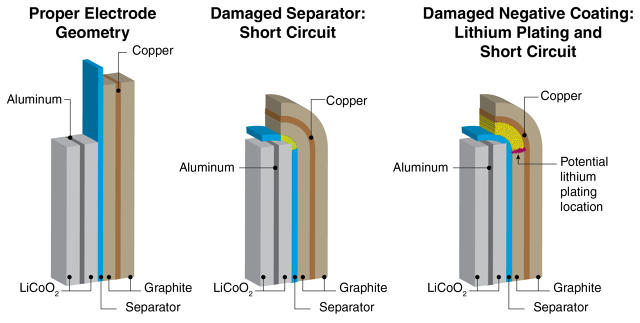The Galaxy Note 7 Explosion Findings Could Change How Samsung Makes Smartphones
After months of confusion about the real cause of the Galaxy Note 7 explosions, Samsung finally provided some answers on Sunday, releasing a detailed report on its findings into the problem. In a micro sense, the explosions were caused by both design flaws and manufacturing errors. In a macro sense, they stemmed from Samsung trying to do too much too fast with lithium-ion batteries. This approach may soon change, and could likely impact the company’s phone designs and the regularity with which Samsung releases new phones.
The Note 7 batteries were made in two different facilities. Those made in Samsung’s own SDI affiliate contained a design flaw that put in contact a positively charged material layer with a negatively charged layer, causing a short circuit. The batteries for the replacement phones that were to be sent out as part of the recall process were produced by another manufacturer called ATL; those batteries began blowing up because of manufacturing issues stemming from a hurried production schedule. Specifically, faulty welding caused the explosive contact between negative and positive layers.
Samsung originally took the Note 7 completely off the market when its internal investigation team could not find a reason for the explosions. Today’s results come from a battery investigation by the U.S.-based UL LLC and Exponent Inc. A German firm studied the manufacturing process used to produce the batteries, but found no significant problems in Samsung’s overall phone manufacturing process.
Pushing Too Hard
The lithium-ion batteries commonly used to power all manner of consumer gadgets have advanced in power efficiency over the years, but perhaps not fast enough to keep up with the demands of an extremely competitive smartphone market.
Samsung asked a lot of the Note 7 battery. When company officials first briefed me on the device back in July 2016, the first bullet points about the new device concerned the increased size (3,500 milliamps) of the battery (larger than the then forthcoming iPhone 7), and how quickly it recharged.
Samsung was also under pressure to make its new phone very thin and sexily designed. The phone was very thin, and the edges of the phone were rounded, creating a softer-looking design. The shape of the battery, then, had to be redesigned to fit within those dimensions. And because of the chemical reactions that happen within the battery, the tiniest design changes matter a lot.

When a lithium-ion battery emits charge, ions flow from a (negative) anode pole to a (positive) cathode pole. The anode pole comprises numerous tightly packed graphite and copper plates, while the cathode pole comprises numerous lithium plates in between. The layers are kept apart by a foil separator. If the anode and cathode poles come into physical contact, the battery can heat up and explode. The thinner the battery, the tighter these elements are packed together. The design constraints on the battery left little room for error in the manufacturing process.
And to make matters worse, Samsung was hurrying to get its new Note 7 out before the arrival of the new iPhone 7 and iPhone 7 Plus in September. Samsung was promising a big, bad battery jammed into a thin device, and delivered on a tight schedule. Nobody knew it then, but the stage was set for a PR and consumer safety nightmare for Samsung.

Changes Ahead
Samsung has already promised U.S. regulators that it will implement a new eight-step quality assurance program at its battery manufacturing facilities. The point is to catch any potentially explosive batteries as they come off the line. An irregularly sized battery, one that doesn’t perfectly fit in the area reserved for it within the phone, would in theory be exposed by the new testing.
But that kind of testing takes time and money. Those eight steps are probably just one example of the many ways that the Note 7 debacle will cause Samsung to slow down its development and production schedules to keep an eye on safety. Samsung also assembled an external panel of battery experts to oversee the creation of future Samsung batteries. The cost of the measures might also slice off a little bit of margin on each premium smartphone sold.
Samsung is known for releasing new phones quickly and often. That’s the spirit that likely motivated the company’s plan to get the Note 7 out before the iPhone 7 showed up. The company might be a bit more thoughtful about its strategy for competing against rivals like Apple. Release timing could slow somewhat. It could cease to be the company’s go-to weapon for competing against rivals like Apple.
The Note 7 debacle might also have an impact on the way Samsung designs its phones. The Note 7 investigation findings show that the phone’s overall design affected the safety of the battery. The thinness of the phone and its rounded edges weren’t the only problems. Samsung packed a lot of components into the phone. The Note 7 had a new iris scanner on board, and retained the analog headphone jack, for example.
Rumor has it that Samsung is already planning to ditch the analog headphone jack in this year’s premium phones, which may create a little more space for the battery. But that may not be enough. Samsung may have to take a hard look at the feature sets and design traits of its phones and decide if any can be given up to create more space for the battery.
Fast Company , Read Full Story
(60)



